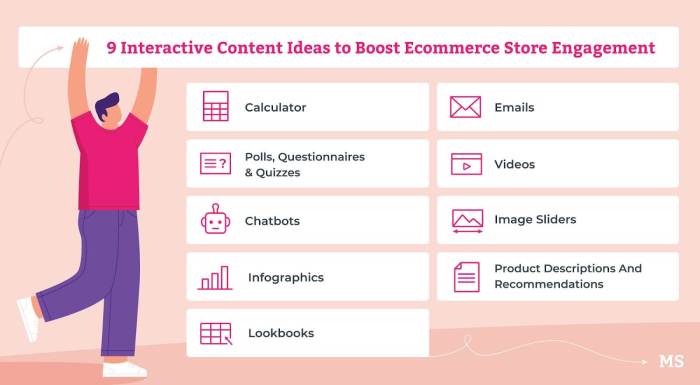Using Interactive Content in Marketing, dive into a world where creativity meets strategy to captivate audiences and drive brand success. From quizzes to games, explore how interactive content revolutionizes marketing efforts.
Discover the power of interactive content in engaging consumers and boosting brand visibility through innovative approaches tailored to modern marketing trends.
Introduction to Interactive Content in Marketing

Interactive content in marketing refers to any type of content that requires active engagement from the audience, such as quizzes, polls, calculators, and interactive videos. This form of content allows users to participate, provide input, and personalize their experience, making it more engaging and memorable.
Interactive content is gaining popularity in marketing strategies due to its ability to capture attention, increase user engagement, and drive conversions. By offering a more immersive and personalized experience, interactive content can help brands stand out in a crowded digital landscape and create a lasting impression on their target audience.
Examples of Successful Interactive Content in Marketing Campaigns
- Netflix’s “Bandersnatch” interactive movie, which allows viewers to make choices that impact the storyline.
- Buzzfeed’s quizzes, which are highly shareable and drive traffic to their website.
- Sephora’s Virtual Artist feature, which lets users try on makeup virtually before making a purchase.
Types of Interactive Content
Interactive content in marketing comes in various forms, each serving a unique purpose in engaging with the audience and driving conversions. Let’s explore some of the most popular types of interactive content below.
1. Quizzes
Quizzes are a fun and interactive way to engage with your audience while also collecting valuable data about their preferences and behaviors. By creating quizzes related to your products or industry, you can increase brand awareness and generate leads. For example, Buzzfeed is known for its entertaining quizzes that not only engage users but also drive traffic to their website.
2. Polls
Polls are a great way to gather feedback from your audience and make them feel involved in decision-making processes. By asking for opinions through polls, you can create a sense of community and increase brand loyalty. For instance, Starbucks often uses polls on social media to involve customers in choosing new flavors or products.
3. Calculators
Calculators provide a personalized experience for users by allowing them to input their own data and receive customized results. This type of interactive content is particularly effective for industries like finance, real estate, or fitness. For example, TurboTax’s tax refund calculator helps users estimate their tax returns, making the process more engaging and informative.
4. Games
Games are a highly engaging form of interactive content that can keep users entertained while subtly promoting your brand or products. By incorporating elements of gamification, brands can increase user interaction and retention. An excellent example is Coca-Cola’s “Happiness Quest” game, which not only entertained players but also promoted the brand’s message of spreading happiness.
Importance of Using Interactive Content in Marketing
Interactive content is a game-changer in the world of marketing, revolutionizing the way brands connect with their audience. By incorporating elements that actively engage users, such as quizzes, polls, and interactive videos, companies can create a more personalized and immersive experience for their customers.
Enhancing User Engagement and Interaction, Using Interactive Content in Marketing
Interactive content is like a magnet for users, drawing them in and holding their attention longer than traditional static content. Whether it’s a fun quiz that reveals their personality traits or a virtual tour of a product, interactive content encourages users to actively participate, leading to increased engagement and interaction with the brand.
Improving Brand Awareness and Customer Retention
When customers have a memorable and enjoyable experience with interactive content, they are more likely to remember the brand behind it. This heightened brand awareness can lead to increased customer loyalty and retention as users develop a stronger connection with the company. By consistently delivering valuable and engaging interactive content, brands can stay top-of-mind and build lasting relationships with their audience.
Statistics and Case Studies
According to a study by Content Marketing Institute, 93% of marketers agree that interactive content is effective in educating buyers. Furthermore, research from Demand Metric found that interactive content generates twice as many conversions as passive content. These statistics highlight the significant impact that interactive content can have on marketing efforts, driving higher engagement, lead generation, and ultimately, sales.
Strategies for Implementing Interactive Content: Using Interactive Content In Marketing

To effectively implement interactive content in marketing, it is crucial to follow specific steps to create engaging material that aligns with overall marketing goals and objectives. Additionally, promoting and distributing interactive content is key to reaching a wider audience and maximizing its impact.
Creating Interactive Content for Marketing Purposes
When creating interactive content for marketing purposes, consider the following steps:
- Identify your target audience and their preferences to tailor the content accordingly.
- Choose the right type of interactive content that best suits your marketing goals, such as quizzes, polls, calculators, or interactive infographics.
- Focus on creating engaging and valuable content that provides a unique and interactive experience for users.
- Ensure the interactive content is mobile-responsive for accessibility across different devices.
Aligning Interactive Content with Marketing Goals
To align interactive content with overall marketing goals and objectives, consider these tips:
- Define clear objectives for the interactive content to ensure it serves a specific purpose in your marketing strategy.
- Integrate interactive elements that support your brand message and values to maintain consistency across all marketing channels.
- Track and analyze the performance of interactive content to measure its effectiveness in achieving marketing goals.
- Iterate and optimize interactive content based on insights gathered from analytics to improve engagement and conversion rates.
Promoting and Distributing Interactive Content
When promoting and distributing interactive content to reach a wider audience, keep the following strategies in mind:
- Share interactive content on social media platforms to increase visibility and engagement with your target audience.
- Collaborate with influencers or industry partners to amplify the reach of interactive content through their networks.
- Optimize strategies by incorporating relevant s and meta descriptions to improve the discoverability of interactive content online.
- Encourage user participation and sharing by making the interactive content easily shareable and integrating social sharing buttons.





